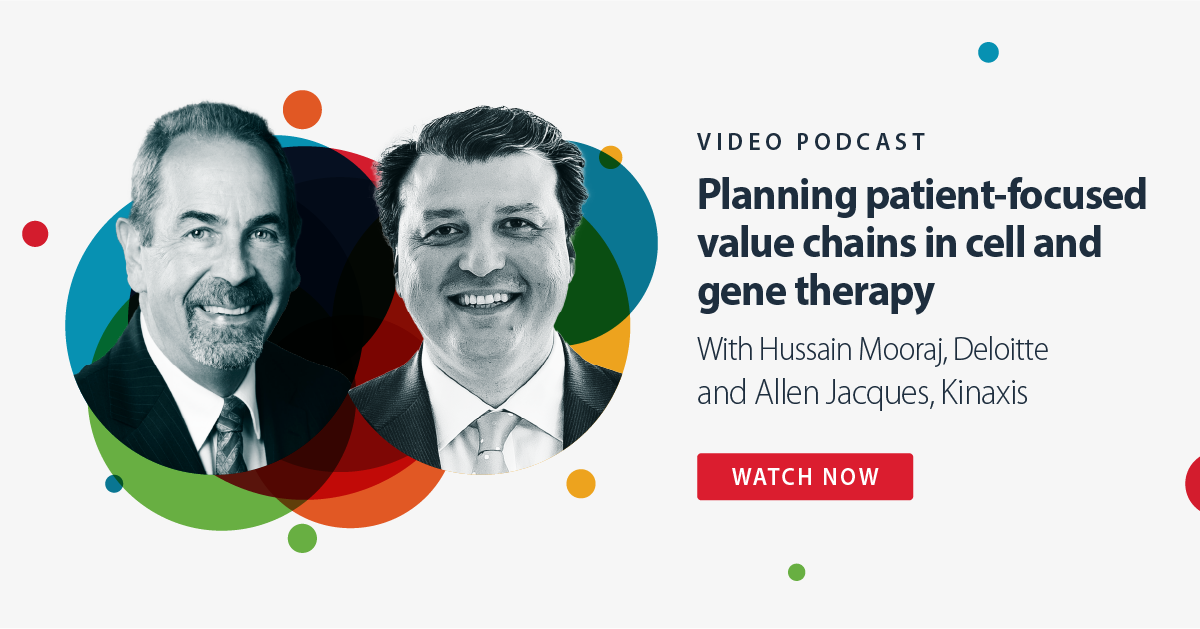I recently had the pleasure of hosting Hussain Mooraj for a session on supply chain challenges in cell and gene therapy, also known as CGT. Hussain leads the Next Generation practice and is a Chief Futurist with Deloitte. He joined me for the first episode of our new season of Big Ideas in Supply Chain, our podcast that connects with supply chain experts and industry professionals to help listeners advance their supply chain processes, drive efficiency and be ready for whatever the future holds. In this episode, we focus on how to develop a value chain based on a single patient and how to do that at scale.
Hussain started off by explaining the sub-verticals in CGT, autologous (CAR-T) therapies, allogeneic therapies, and gene therapies. He also noted that within gene therapy there are in vitro and in vivo sub-verticals. We then focused on the first sub-vertical, autologous CAR-T.
How supply chains must adapt for today’s biopharmaceutical products
Autologous cell therapy is a “vein to vein” supply chain where cells are harvested from a patient through a process known as apheresis, transported to a manufacturing site for modification/activation against a cancer marker, and then returned to the hospital for infusion back into the patient. It is a very time- and temperature-sensitive supply chain with, in some cases, cryogenic shipments down to -140° C. Delivery is “white glove” hand carried to certified and named individuals. It is also a supply chain where exceptions are the norm due to factors such as postponement due to patient health, cell viability thresholds after modification, capacity constraints, key material supply, such as viral vectors, and more.
The first CGT product was launched in 2015 and growth since then has been massive. In 2019 there were 27 products launched globally, 89 so far this year, and over three thousand in development as of December 2021. The U.S. Food and Drug Administration is seeing hundreds of IND (Investigational New Drug) applications coming in every year, more than for all small and large molecule products combined, and several years ago the agency predicted 20 – 25 approvals of CGT products a year through 2025.
Hussain explained that traditional BioPharma supply chains are designed around products with make-to-stock push strategies. CAR-T therapies require a radical mind shift and supply chains that are make-to-order, pull and designed around the patient. He gave an example of a supply chain executive from traditional pharma who never had contact with patients and with sales and marketing barely once a quarter. When he moved into CGT, this morphed into frequent patient interactions and daily communication with the commercial organization, regulatory department, development and clinicians.
How companies can meet the unique challenges of planning CGT supply chains
I summarized that we are looking at two challenges in this space. The first is rock solid execution from cell collection to cell modification and then back to infusion into the patient. This execution must be flawless because a life is hanging in the balance, and there is no backup. The second challenge is in the constant planning and replanning of the supply chain due to the high number of exceptions and changes in the ecosystem, i.e. the balancing of expected cell collections within narrow windows, lead times, manufacturing and laboratory testing capacity, material supplies, shelf-life constraints, etc. This planning must be concurrent, rapid, capable of quick simulation and scenario generation, transparent and collaborative across all stakeholders, and, most importantly, lead to timely and optimal decision making. All of this is focused solely on the patient.
I ended the session by asking Hussain what advice he would give to someone entering this space, what lessons he had learned over the years. His first piece of advice was to “fail fast”, especially around innovation. The technology is young with many new entrants, so when something is not working internally or externally, be willing to pull the plug quickly and move on to another solution. Secondly, he advised to innovate outside of the four walls of your company, form true strategic partnerships and invest heavily in them. Thirdly, to attract and retain key talent and expertise — scientific, technical, and functional. You bring in deep science with strong functional capabilities, e.g., supply chain, and then strongly underpin them with digital capabilities. The three of these need to go hand in hand in cell and gene therapy. And lastly, he said to think long and hard about your operating model. Many companies try to use existing operating models, and it just does not work. There needs to be a nerve center concept to support the evolution of traditional capabilities and nimble decision making. You want to bring the science, technology and functional aspects closely together in a nimble environment. This requires a nerve center with dedicated, focused capabilites and operating model.
I hope you’ve enjoyed this preview of our discussion. Our full conversation goes into further depth on these topics and more. You can watch our conversation here, or listen and subscribe to our podcast here or on your preferred subscription service. Then, be sure to visit our Big Ideas in Supply Chain Community for more practical and strategic expertise from the greatest minds in supply chain.






